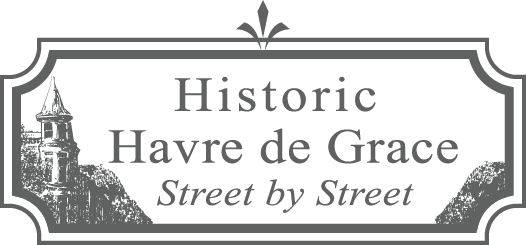Back to All Listings
615-617 Green Street, St. James A.M.E. Church, c. 1874
The 1800s were a time when Blacks were “discouraged” from using the same churches as whites. This church had its start in 1849 when a small group of the city’s free black population met at the double-brick home of James Peaco, Sr. and his wife Ellen, near Havre de Grace. Later they met at Mount Zion Meeting House and after that in the Anderson Institute on Linden Alley (the latter established by the Freedman’s Bureau for the education of Negro children). The Anderson Institute building has most likely been demolished and the current blue building on the site may be its replacement.
In 1873 under the leadership of Rev. Joseph Robinson the African Methodist Episcopal congregation trustees bought this tract of land on Green Street and in 1874 the Mount Zion Meeting House was moved to this site by the “men of the Church with the aid of Mr. Tobias Skinner’s horse.” Some of those trustees were James Peaco, Sr. and his wife Ellen, James Peaco, Jr., Gideon Bosley (1812-1893), Jesse White (1834-1890) and his brother Samuel White, and Tobias Skinner (1824-1884). In 1875 the congregation renamed the meetinghouse as “St. James AME Church,” in honor of one of its faithful fathers and treasurer, James Peaco, Sr.
The 1885 and 1894 Sanborn Maps show “African Church” here; the 1899 Map shows “St. James AME Church”; and the 1921 Map shows “St. James AME Church, Colored” at this location on the corner of Centennial Lane and Green Street.
Over the years, several improvements have been made to the one-story church. The vestibule on the front of the church was added around 1900, containing glass and aluminum doors with a semicircular stained glass transom above them. It has a gable roof like the main section. And the church, with its paneled barrel-vaulted ceiling on the interior, was faced with a stucco-pebbled finish in the 1940s.
In 1943, during a time when the finances of the church were “worrisome” to the members, a local resident, John Leo Jones (1893-1973) quietly bought the mortgage of the church. Leo Jones was head waiter at the Colonial Hotel on South Union Avenue and was a good friend of Charlie Burkett, who for many years was the chauffeur of philanthropist Frank “Donaldson” Brown (1885-1965) who built the mansion at Mt. Ararat Farm in Cecil County. The ties between the three men connected Donaldson to issues affecting the African-American community in Havre de Grace. Many church members believed it was from Donaldson Brown that the funds came for the mortgage. Jones was very informed on political issues in the city and many called him the “Black Mayor” of Havre de Grace. He and his wife, Samantha, had five children and lived at 551 Girard Street. He was a charter member of Evening Star Chapter No. 20, Order of the Eastern Star. John Leo Jones’ great-granddaughter now serves as church secretary of St. James Church.
On January 17, 2016, with a look to the future, the church officially established an Endowment Fund when their Endowment Committee presented a check in the amount of $25,000 to the Reverend Dr. Baron Young and to Presiding Elder Cordell Hunter. The Fund leaves a lasting legacy by allowing interest from invested capital to be used for future generations and provides assurance that the church will carry on.
In 2017, the 1899 frame house on the east side of the Church went on the market and the Church purchased it. Soon after that the Church demolished the house and seeded the lot, which remains empty.
From its beginning, the oldest African American Church in Havre de Grace, St. James, has been served by 43 pastors–from Rev. W. M. Waters to the current pastor, Rev. Dr. Baron D. Young.
County Records
Built 1874. 6346 sq ft, exempt commercial. 9000 sq ft lot
Built 1874. 6346 sq ft, exempt commercial. 9000 sq ft lot
